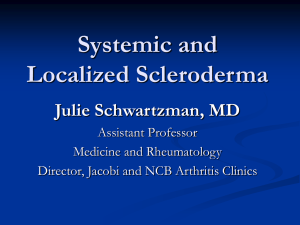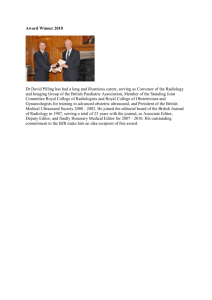MPEE Mentored Professional Enrichment Experience Applicant
advertisement
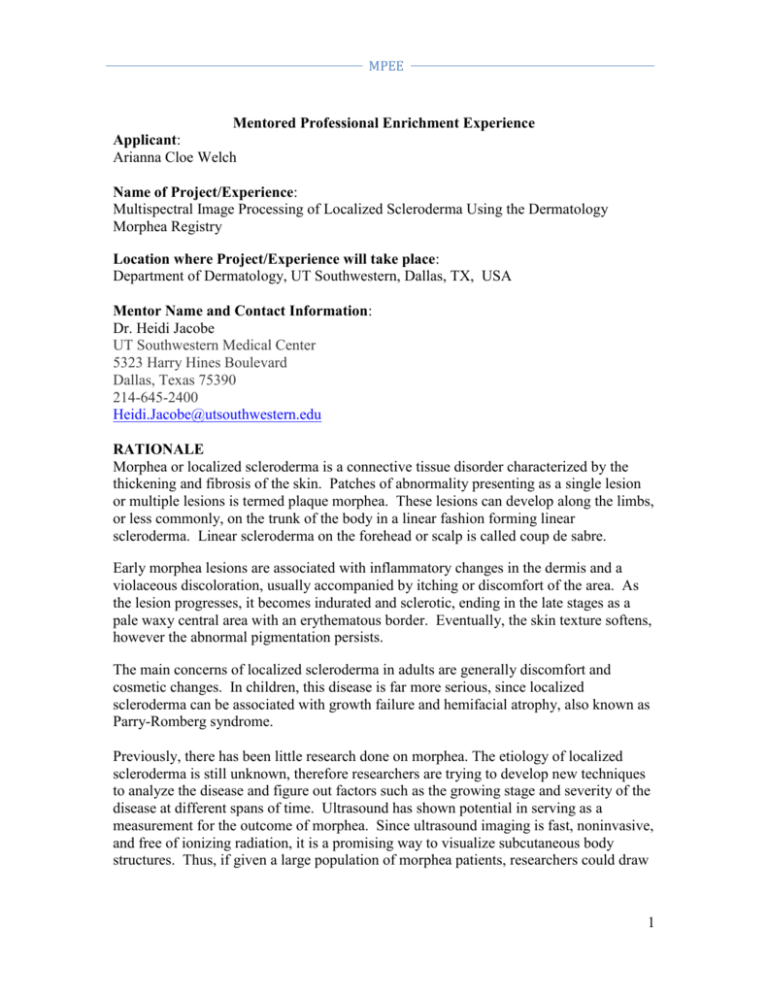
MPEE Mentored Professional Enrichment Experience Applicant: Arianna Cloe Welch Name of Project/Experience: Multispectral Image Processing of Localized Scleroderma Using the Dermatology Morphea Registry Location where Project/Experience will take place: Department of Dermatology, UT Southwestern, Dallas, TX, USA Mentor Name and Contact Information: Dr. Heidi Jacobe UT Southwestern Medical Center 5323 Harry Hines Boulevard Dallas, Texas 75390 214-645-2400 Heidi.Jacobe@utsouthwestern.edu RATIONALE Morphea or localized scleroderma is a connective tissue disorder characterized by the thickening and fibrosis of the skin. Patches of abnormality presenting as a single lesion or multiple lesions is termed plaque morphea. These lesions can develop along the limbs, or less commonly, on the trunk of the body in a linear fashion forming linear scleroderma. Linear scleroderma on the forehead or scalp is called coup de sabre. Early morphea lesions are associated with inflammatory changes in the dermis and a violaceous discoloration, usually accompanied by itching or discomfort of the area. As the lesion progresses, it becomes indurated and sclerotic, ending in the late stages as a pale waxy central area with an erythematous border. Eventually, the skin texture softens, however the abnormal pigmentation persists. The main concerns of localized scleroderma in adults are generally discomfort and cosmetic changes. In children, this disease is far more serious, since localized scleroderma can be associated with growth failure and hemifacial atrophy, also known as Parry-Romberg syndrome. Previously, there has been little research done on morphea. The etiology of localized scleroderma is still unknown, therefore researchers are trying to develop new techniques to analyze the disease and figure out factors such as the growing stage and severity of the disease at different spans of time. Ultrasound has shown potential in serving as a measurement for the outcome of morphea. Since ultrasound imaging is fast, noninvasive, and free of ionizing radiation, it is a promising way to visualize subcutaneous body structures. Thus, if given a large population of morphea patients, researchers could draw 1 MPEE conclusions on this novel disease using ultrasound imaging plus computer image processing. Currently, UT Southwestern is heading the investigation of localized scleroderma. They have created a Morphea Registry and DNA Repository to answer many questions associated with the disease. Researchers are comparing morphea’s association to other diseases, as well as inspecting the genetics behind the disease. Dr. Jacobe and other dermatologists at UT Southwestern are using volunteers previously diagnosed with morphea and several standardized patients to establish the registry. They are collecting information about the volunteers’ other health conditions, family medical history, social history, as well as collecting blood and skin samples to further define the genes associated with morphea and the genetic faces of morphea. They have also completed ultrasound imaging on various participants. Using these images and computer processing, implications can be drawn on the progression of the disease through interpretation of the echogenicity, vascularity and tissue thickness of the outbreaks, which will help physicians determine the severity of the disease at different stages. GOALS The goals of my project are: 1. Group and organize data from an already comprised Morphea registry 2. Learn how to interface both Matlab and GNU Image Manipulation Program (GIMP) 3. Use my engineering background of Matlab to analyze ultrasound images of Morphea lesions in various patients of the registry using GIMP software 4. Interpret the processed image to obtain the region of interest and then determine tissue thickness, evaluate echogenicity, and evaluate vascularity index using the Ultrasound Disease Activity Measure (U-DA). 5. Personally, gain a larger understanding of dermatology 6. Expand my clinical experience in dermatology clinics 7. Attend Dermatology Journal meeting and engage in conversation with Dermatology interns, residents, and physicians By the end of eight weeks, I hope to have made a sizable contribution, if not finished, the engineering project of visually processing the location of outbreaks of morphea from affected patients in the registry. I also hope to gain a greater knowledge of the dermatological field. In addition, the summer will encourage me to meet other medical school students and new professionals in the medical field. METHODS Image analysis in various segments of pathology has become an extensive and useful interest for many researchers. For the application of image analysis, Matlab software is a developed tool aimed at use by scientists with engineering expertise. The software has many built-in functions, which support image processing. All of the ultrasound images have been stored in Tagged Image File Format (TIFF). Matlab has the ability to read and display these TIFF images by the functions imread and 2 MPEE imshow. After opening the images, I plan on using image analysis algorithms by Matlab command functions like imtool which calculates the intensity values of the image and rgb2gray which converts images into a gray scale. Once represented in gray scale, I will need to define the low and high intensities of the image. Using this information, I will try and form a binary image of the region of interest from 2-D convolution of matrices. If noise is present, I can use a median filter to remove it. To further improve the image, I will utilize GIMP which is one of the most common platform independent image editing softwares available for scientific purposes. Using the GIMP Octave Plugin, I can easily run Matlab right out of the GIMP environment. This environment will allow me to complete detailed pictures mapping the region of interest of the morphea lesions. Results obtained from the image processing software will be in pixel regions which can be converted into centimeters and compared to Ultrasound Disease Activity Measure (UDA). I can calculate the thickness of the region of interest in centimeters and compare to normal skin thickness outside the region. I will then compare these calculations to the tissue thickness score from the U-DA. Comparing the intensity of the region of interest and normal skin, I can obtain a echogenicity score. Comparing the pixels of the region of interest and normal skin, I can obtain a vascularity score from the U-DA. I will repeat this process for at least 50 ultrasound images. ANALYSIS When 8 weeks is done, I will have completed the processing and interpretation of ultrasound images on vascularity, echogenicity, and tissue thickness. I will be able synopsize the data of various patients and as a longitudinal growth progression of the disease. Using the U-DA values, I will be able to classify normal values that correspond to severity and stage of the disease. This study could enhance knowledge of the disease and become an effective tool for diagnosing morphea. Ideally, I would help get the experiment published in a scientific or engineering journal, so physicians can use the research to track patients through the different stages of morphea. SUPPORT 1. Do you request support funds? Yes 2. Would ou be able to participate if a scholarship is not available? No REFERENCES: 1. 2. 3. 4. Adnan, Zainal Arifin. Diagnosis and Treatment of Scleroderma. Acta Med Indones. 2008 April; 40 (2): 109- 112. Markiewicz, Tomasz. Using MATLAB software with Tomcat server and Java Platform for remote image anaylsis in pathology. Diagnostic Pathology. 2011; 6 (Suppl 1): S18. Mistry, Vishal et etc, Evaluation of Echogenicity, Vascularity Index, and Tissue Thickness of Localized Scerloderm. Bioengineering Conferene 2011 IEEE 37 th Annual Northeast, 1-3 April 2011; pg. 1-2. Sclereoderma Registeries. Scleroderma Foundation. < http://www.scleroderma.org/medical/SDRegistries/SD-Morphea-Registry.shtml> 3
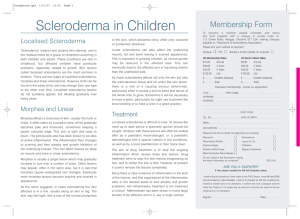
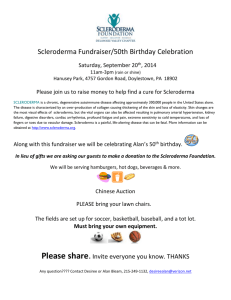
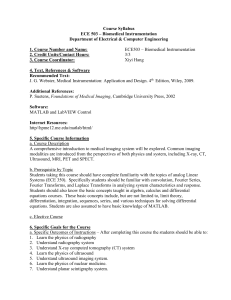
![Jiye Jin-2014[1].3.17](http://s2.studylib.net/store/data/005485437_1-38483f116d2f44a767f9ba4fa894c894-300x300.png)

